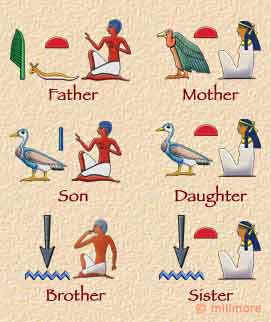Chapter 2 The First Civilizations
Section
2
While
the city-states of Sumer proved the most effective way for Mesopotamians to
adapt to their environment, a thousand miles away, in Africa along the river
Nile, human beings established a different way of living. The differences
between the civilization of Mesopotamia and that of the Nile Valley directly
reflected the differences in the two environments.
The
Nile Valley
The
river Nile is the longest river in the world, flowing some 4,160 miles from
south to north. It rises from two principal sources: the White Nile rises from
the central African lakes of present day Rwanda, Burundi, Uganda, Tanzania and
Kenya. Fed by numerous smaller streams, or tributaries,
it makes its way north nearly two thousand miles through the present-day Sudan.
At Khartoum, it is joined by the Blue Nile, which springs fresh from Lake Tana
in the highlands of Ethiopia some five hundred miles away to the southeast.
From Khartoum the mighty river flows on to the north, over six major cataracts, or falls, winding its way through some of the worst desert on earth, through a valley sometimes broad and sometimes narrow, often lined with steep cliffs that virtually cut off access to the waters from the land. For its last 1600 miles, the Nile flows alone, with no branches or tributaries. As it nears the lowlands along the Mediterranean coast, at modern day Cairo the river begins to spread out in a delta region that is a virtual maze of channels and swamps, filled with great water plants, the famed papyrus, before finally seeping into the Mediterranean Sea.
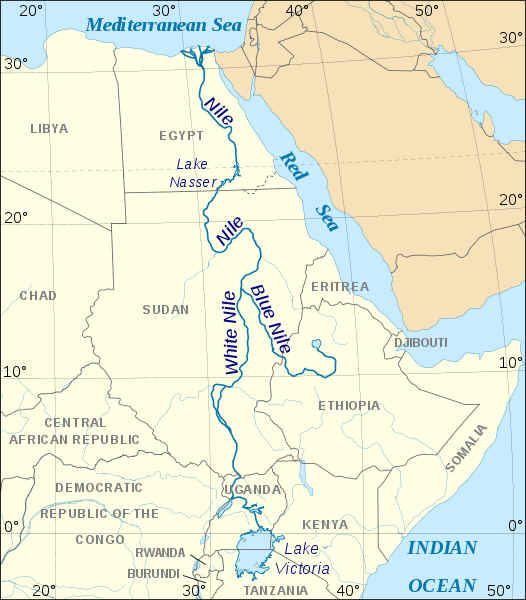
http://upload.wikimedia.org/wikipedia/commons/thumb/5/59/Nile-en.svg/526px-Nile-en.svg.png
Unlike
the Tigris and Euphrates, which were dependent upon the often unpredictable
weather patterns of the eastern Mediterranean and the Turkish highlands, the
Nile's flood depended upon the annual melting of year-round snows in the high
mountains of north-central and northeast Africa, and heavy annual rains in the
upper valleys of the Blue Nile in Ethiopia. Both the rains and the snowmelt
occur with little variation from year to year, although periodically shifting
weather patterns could delay the rains or even lessen their volume. This meant
that the annual floods were almost always predictable, with only occasional
periods during which they might be delayed or lessened in volume.
Although
the channels of the Delta may shift somewhat, with no severe storms upriver to
affect the river's flow the annual flooding even of this lower region is still
more predictable and less destructive than that of Sumer. Upriver, where the
Nile flows relatively swift and untroubled within its banks, the flood is also
generally predictable and steady - again very different from the Tigris and the
Euphrates. Like the Mesopotamian rivers, however, the Nile too brought rich
deposits of silt down from the volcanic highlands, renewing the fertility of the
river valley's soil every year. The annual flood of the Nile thus made its
valley one of the richest agricultural areas in the world.
In
addition to the river, the Nile Valley has several other distinguishing
characteristics that affected the style of civilization that developed there.
Although in the late Neolithic period the surrounding territory was relatively
well watered by rain, by about 3000 B.C., when civilization emerged in the river
valley, climate changes had begun to make the surrounding lands virtual deserts.
These deserts seem to have served for a time as a barrier to outside invasion of
the river valley by nomadic peoples. The river too, although navigable for
considerable portions of its length, was marked by a series of cataracts, or
rapids, which made access from the far south difficult. Moreover, with little or
no rain, especially in the southern part of the valley, the single most
important natural feature dominating the landscape, apart from the Nile itself,
was the glaring, hot African sun. As might be expected, the Egyptian view of the
world was forged between the hammer and anvil of the mighty river Nile and the
Lord of Heaven, the Sun.
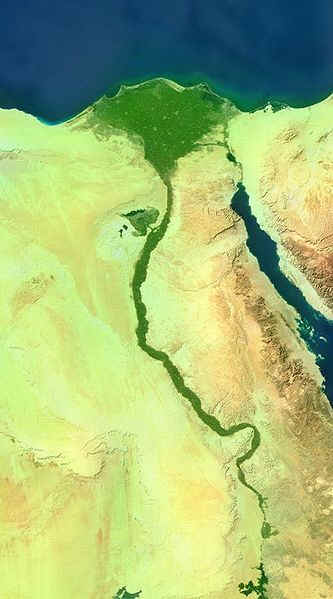
The Nile River and delta surrounded by desert as seen from space. http://upload.wikimedia.org/wikipedia/commons/thumb/5/5b/Nile_Valley.jpg/333px-Nile_Valley.jpg
Origins
of Egyptian Civilization
The
basis of civilization in the Nile Valley, as in ancient Mesopotamia, lay in
Neolithic farming villages that the people of the region had gradually
established between about 10,000 and 3000 B.C. Why these relatively autonomous
communities began to come together remains something of a mystery, but it is
reasonable to suggest that climatic changes, particularly desertification,
or drying out, of the Sahara, which gradually confined human existence to the
river valley itself, was the primary cause. As the surrounding region became
drier and drier, people naturally moved closer and closer to the water supply on
which their food production depended. More people living closely together in
turn fostered the need for greater organization, in short, civilization.
Within
this basic scenario, recent archeological findings suggest that at least three
separate types of culture contributed to the emergence of civilization along the
Nile. The upper reaches of the river produced highly organized and prosperous
farming communities, which were gradually brought together under the rule of
local leaders in a kind of plantation system. Eventually a single leader united
all of them into a kingdom, known as Upper Egypt.
This
unifying process in turn was probably carried out under the influence of
surrounding pastoralists, who lived in the arid, but still habitable plains away
from the river itself, both to the east and the west. These pastoralists
declined in importance as their grazing lands dried up; eventually they were
either absorbed or ridiculed as 'barbarians' by the inhabitants of the river
valley.
Meanwhile, in the delta region to the north, an even more sophisticated culture was emerging, in which long-distance trade and commerce, particularly with the east, matched the importance of agriculture. The delta too was eventually unified, if rather loosely, under a single leader, but perhaps because of its primary interest in trade and commerce the delta kingdom seems to have been less warlike than its southern neighbor. The dangers of such a peaceful attitude became clear around 3100 B.C. when the king of Upper Egypt, traditionally named Menes, conquered the delta and proclaimed himself Pharaoh, Lord of the Two Lands.
INTERNET
RESOURCE: The Ancient Egypt Site
Patterns
of History: The Dynastic Cycle of the Pharaohs
Traditionally,
civilization in the Nile valley is said to begin with the unification of upper
and lower Egypt under the first Pharaoh, Menes, in 3100 B.C. The history of the
civilization is usually divided into three periods in which the valley was
unified under the authority of a series of some thirty ruling families, or
dynasties (hence the term Dynastic Period), separated by two Intermediate
periods, when the central power disintegrated.



The Red Crown of Lower Egypt (left), the White Crown of Upper Egypt (center) and the Double Crown of Pharaoh, Lord of the Two Lands (right) http://en.wikipedia.org/wiki/Pschent
The
first dynastic period occurred in two stages: the Archaic Period of the first two dynasties, when the patterns for
Pharaonic rule were being firmly established; and the Old Kingdom. Altogether,
six dynasties ruled during this era of about 800 years, in relative peace and
prosperity. Gradually, however, as the dynasties placed more and more emphasis
on expensive state projects, such as building the pyramids, the people of Egypt
began to be overtaxed and impoverished. As disillusionment with the Pharaohs set
in, local provincial governors began to gain more and more power for themselves.
Eventually,
squabbling among these local nobles resulted in the downfall of the Pharaoh's
central authority. Beginning in about 2160 B.C., a period of civil war led to
the collapse of central authority. For nearly 150 years the Nile valley
experienced political disunity, as local nobles fought with one another, perhaps
over the right to call themselves Pharaoh. This period is known as the First Intermediate Period.
In
about 2040 B.C., the rise of the 11th dynasty signaled the reunification of
Egypt and the beginning of the Middle
Kingdom, which saw the accomplishments of the Old Kingdom expanded and
spread to benefit not just the Pharaohs, but the general population as well.
Learning the lessons of the end of the Old Kingdom, under the 12th dynasty in
particular, pharaohs began to pursue policies that centered less on their own
roles as god-kings and more on improving the lives of their subjects.
By
about 1782 B.C., however, dynastic rule of the pharaohs weakened once again as nobles
and priests struggled among themselves for more power. Then, beginning in the
1760s, foreign marauders began to attack Egypt. These attacks culminated in the
first full-scale foreign invasion of the valley. The fall of the 12th dynasty to
these invaders in 1650 B.C. marked the beginning of two centuries of foreign
domination and internal turmoil. This Second Intermediate Period
was finally brought to an end in 1570 B.C., when the founder of the 18th
dynasty, Ahmose,
reunited all of Egypt and threw out the last of the foreign invaders.
Ahmose's
success marked the last dynastic period, sometimes called the Late
Kingdom, but usually referred to more accurately as the period of the Empire.
The Empire in turn lasted until the conquest of Egypt by more foreign invaders,
first from the west, then the south, and finally from the east, when Egypt was
incorporated into the Assyrian empire in 670 B.C. Although Assyrian rule only
lasted about 18 years, followed by a brief but brilliant renaissance of
indigenous Egyptian culture, the final blow came at the hands of the Persians,
who conquered the valley in 525. After the Persian conquest, Egypt never really
recovered its independence from foreign rule until the 20th century A.D.
The
Structure and Character of Egyptian Civilization
Although
scholars argue over why the inhabitants of the Nile valley moved from the stage
of Neolithic farming villages to the emergence of civilization, the best
evidence still points to a combination of environmental factors. The Nile, like
the Mesopotamian rivers, required considerable work to make it sustain farming.
In Upper Egypt, where the river flowed through straight banks, canals had to be
dug to bring the water to the fields. During the flood, farmers had to build
levies, or embankments of earth, to channel the waters into fields or
containment areas where they could be stored for future use.
In
the delta too, the flood had to be controlled, lest it destroy the fields on
which people depended for survival. All this activity required the same kind of
organizational skills that the ancient Sumerians had worked out. These skills
had emerged in Egypt, however, long before the beginning of what we would now
call civilization; consequently, there must have been more to Egypt's move to
civilization than simply the development of irrigation agriculture.

Modern irrigation canal in the Nile delta. http://girlsoloinarabia.typepad.com/photos/egypt/nile_delta2.jpg
Surplus
food production, so important in all civilizations, had produced thriving
communities along the Nile well before the dynastic period. They probably began
to get bigger because of the changing climate. As the surrounding lands got
drier more and more people moved close to the river. It was probably this
climatic change that caused the development of even greater levels of
organization, eventually leading to the creation of kingdoms and finally the
unification of Upper and Lower Egypt.
The
archeological record tells us that for all the regularity of the Nile, and the
fertility of the soil, the Nile Valley experienced periods of drought, when
normal levels of food production dropped dramatically. The biblical story of
Joseph, who became a chief adviser to Pharaoh because of his prediction that
seven fat years would be followed by seven lean years, and that Egypt would be
saved by storing grain during the fat years, reflects a central pattern of
Egyptian history. Flooding too could destroy crops in years when the annual Nile
flood was much higher than usual. Such events were not as frequent in Egypt as
in Mesopotamia but they were sufficiently threatening to human existence that
Egyptians began to store grain during seasons of plenty to be used in times of
famine.
Large-scale
food storage, and distribution of such surpluses when the time came, required an
even greater level of organization than simply tapping into the Nile. As local
leaders began to create such surplus storage facilities, they naturally became
both social and political leaders on whom other members of the community
depended for survival in hard times. Out of this pattern, the real authority of
the Pharaohs gradually emerged, first at the local level, then through regional
kingdoms, and finally throughout the entire Nile Valley.
Probably
because of this complete dependence on agriculture, civilization in Egypt, as in
Mesopotamia, was also seen as an extension of the underlying religious order of
the universe. The old Neolithic view of Nature as fundamentally alive also
prevailed here. The forces of Nature were immortal spirits, gods and goddesses,
who insured the continuity of the world in which people lived. Those specialists
who understood them, the priests, naturally became the leaders of Egyptian
society.
An
Egyptian Worldview.
Here, however, the pattern that emerged in Egypt took a different path
from that of Mesopotamia. After unification of the Nile valley, and the drying
up of the surrounding territory, in Egypt there was little threat from outside
invaders. Nor was there much competition among villages for water resources, due
to the constant abundance of the Nile. Consequently, the Egyptian conception of
what the natural world was like varied dramatically from that of Mesopotamia.
Egyptians saw life from the vantage point of relative security. The measured
flow of the Nile marked the slow, generally peaceful hours of their lives, from
generation to generation. Optimism rather than the Mesopotamian pessimism
colored all aspects of Egyptian life.
The
essentially secure character of life in Egypt also meant that the nature of
cities developed differently from those of Mesopotamia. Egyptian cities were
originally less cities in the modern sense of the word than ritual centers. Even
after the unification of upper and lower Egypt, the vast majority of Egyptians
continued to live in their agricultural villages.
Cities
developed primarily as centers for grain storage and the religious rituals that
surrounded food production - or life itself as the Egyptians saw it. They were
occupied permanently by Pharaoh, his court, and the priests and their
attendants, but only visited by the rest of Egyptian society for religious
occasions, or to obtain food supplies when necessary.
Consequently, they had no significant defensive walls and the most important buildings were the
great temple complexes and royal palaces, which were often connected with
granaries.
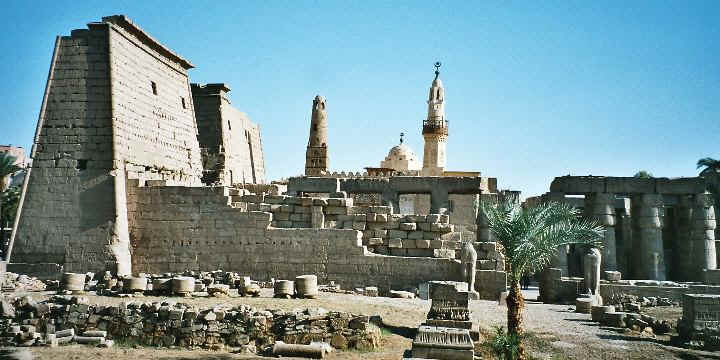
Ancient Thebes, the principal capital of Egypt from about 2060-1685 BC, and again from 1580-1353 BC, and for the final time from 1332-1085 BC, lay on both sides of the Nile about 419 miles south of modern Cairo. At its height, Thebes covered some six square miles, mostly on the east side of the river (the necropolis, or 'city of the dead' lay on the west side of the river and was primarily comprised of the mortuary temples of the pharaohs, as well as the homes of all those who tended them - priests, craftsmen, workers and guards.) At the heart of the city on the east bank were two great temple complexes dedicated to the sun god Amun-Re, one at Luxor (photo above http://en.wikipedia.org/wiki/Luxor) which lay to the south, and especially the great complex of Karnak (photo below), situated two miles further north and encompassing some two square miles in its own right. A magnificent ceremonial road, lined on both sides by statues of sphinxes and rams, ran the two miles between the two temples of Amun-Re. In addition, the Karnak complex also contained shrines and small temples to various other gods; and two smaller self-contained temple complexes lay nearby, one dedicated to the war god Mont, and the other to the goddess Mut, the wife of Amun. Unfortunately, the palaces, houses and gardens that would have been occupied by pharaohs and their courtiers and administrators have not been preserved.
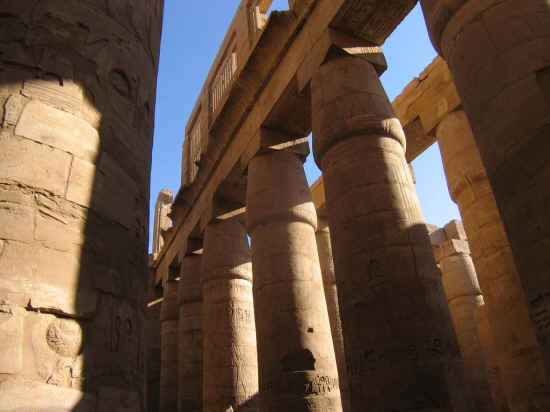
Hypostyle hall of the magnificent temple of Amun-Re at Karnak, http://en.wikipedia.org/wiki/Karnak
There
were, of course, private residences for courtiers, and over the years these
became increasingly important. During the Middle Kingdom, too, a rising middle
echelon of Egyptian society, composed of artisans, merchants, and other
non-agrarian specialists, made private dwellings and civic architecture more
prominent, but in general the cities of Pharaonic Egypt continued to reflect the
complete identification of temporal, or worldly power, with spiritual authority.
Egyptians simply did not distinguish between the two, as did the Mesopotamians.
Church
and State met in the person of the Pharaoh, who stood at the center of ancient
Egyptian society for most of its history. Although Pharaoh, like the ancient
Sumerian kings, was both king and chief priest, these two roles were combined
differently in Egypt than they had been in Sumerian experience. While it is at
least arguable that kingship in both civilizations developed out of the early
need for military leadership, in Egypt, once the valley had been united under a
single ruler, the priestly aspect of kingship overshadowed the military aspect.
During
the Archaic period of the first two dynasties, Pharaoh's role was far more
dependent upon his ability to provide food during times of natural hardship than
upon his role as a general. Consequently, his function became connected with the
rhythms of agriculture as practiced in the Nile Valley. Like all other aspects
of the early Nile valley civilization, these rhythms reflected the Egyptians'
spiritual conception of the nature of the universe and humanity's role in it.
Egyptian
Religion. In
Egypt, as in Mesopotamia, the Neolithic conviction that the natural world was
alive continued to dominate people's conception of reality. Consequently, here
too life was seen primarily in religious terms, with the physical world as
simply an extension of the spiritual world. The nature of the spiritual world,
however, was very different for ancient Egyptians than it was for ancient
Mesopotamians. Where the gods and goddesses of the Land Between the Rivers were
as fickle and violent as the natural forces in which they showed themselves, in
Egypt the gods reflected the relatively gentle and predictable nature of life
along the Nile.
Even
before the unification of Egypt, the river itself was a primary deity in the
Neolithic farming villages, since it was a principle source of life. The ancient
“Hymn to the Nile” expressed Egyptians’ gratitude for the river’s
life-giving force:
"Hail
to thee, O Nile, that issues from the earth and comes to keep Egypt alive!
…When the Nile floods offering is made to thee, oxen are sacrificed to
thee…birds are fattened for thee, lions are hunted for thee in the desert,
fire is provided for thee. And offering is made to every other god, as is done
for the Nile…. So it is ‘Verdant art thou!’ So it is ‘Verdant art
thou!’ So it is ‘O Nile, verdant art thou, who makest man and cattle to
live!’"
The
rhythms of life that followed the Nile's constant flow were naturally seen as
the rhythms governing the entire universe. Life for the Egyptians was a
never-ending cycle of birth, life, death, and regeneration or rebirth, a pattern
that was all around them in the annual flood of the great river, and the
constant regeneration of Egypt's fertility. The constancy of the Nile was like
the heartbeat of ancient Egypt, an eternal pulse that never failed.
Equal
in importance to the Nile, however, was that great power that constantly
overlooked human affairs, the sun. Traveling on its daily journey across the
sky, the sun was just as constant, indeed, even more constant, than the Nile.
Given its overarching height, Neolithic Egyptians could easily imagine the sun
as a guardian spirit, infused with light that protected them from the dangers of
the night. Like the river too, the sun was eventually understood as a giver of
life to both the earth and human beings, and so was worshipped in Egypt as a
good and vital force governing people's lives.
Before
the unification of Egypt under Menes, the local farming communities worshiped
these two great powers, along with other lesser spirits, under a variety of
names. The lesser deities generally represented forces or natural features that
were particularly important to the individual villages. With the unification of
the Nile Valley, however, the gods too were unified.
Since
the sun was clearly the most obvious guardian power, looking down from on high,
local guardian deities were generally fused into the single great god of the
sun, Re (or Amon-Re
as he was called during the Middle Kingdom, after the chief god of the city of
Thebes, whose dynasty had reunited Egypt). In the same way, all local gods or
goddesses associated with the regenerative powers of the Nile and the vegetation
that depended on it (and that so clearly mimicked its own rising and falling
pattern in the cycle of life, death, and rebirth) were gathered into the great
god Osiris. During the dynastic era, both great gods of Egypt were
brought together in a single earthly representative immediately visible and
approachable by human beings, Pharaoh.
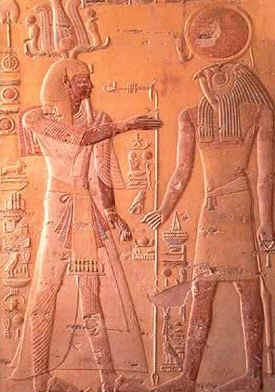
Re-Horakhty ("Ra is Horus of the Horizon") on the right above faces with Osiris on the left. Note the solar disk and the falcon Horus in the image of Re - both are representations of the sun. http://www.touregypt.net/featurestories/re.htm
With
little need for military protection after the unification of Upper and Lower
Egypt, Pharaoh's role was not so much to maintain external security as to
perpetuate the constant cycles of Nature and the order of the universe.
Reflecting this function, his life from beginning to end became one long
religious ritual - re-enacting, and thereby sustaining, the rhythms of the
universe.
In
fact, Pharaoh came to be seen as an earthly embodiment of more than one god,
depending upon which phase of his life he happened to be in. In the Old Kingdom,
by the time of the Fourth Dynasty he was primarily associated with the sun god, Re. Although the sun was seen as a
bringer of life, Egyptians realized that it could also be a bringer of death,
particularly when separated from the life-giving waters of the Nile. Egyptians
resolved this apparent duality in the sun's nature by seeing Re not only as a
guardian, but also as the god of truth, justice, and righteousness, responsible
for upholding the moral order of the universe, and bringing life or death
according to the merits of the individual.
According
to tradition, Osiris had been a great king who had taught his people the arts of
civilization, and particularly the secrets of agriculture. This benevolent
ruler, however, was murdered by his evil brother, Set, who cut the body into pieces and scattered them throughout
the land. Osiris's wife, who was also his sister, Isis, thereupon journeyed
throughout Egypt, gathering up all the pieces. Putting them all together again,
she miraculously restored Osiris to life, at least long enough to make her
pregnant. Osiris then went down into the underworld to become the judge of the
dead.
The
development of the Osiris myth reflected not only an increasingly moral element
in Egyptian religion, but also a promise of eternal life that soon extended
beyond Pharaoh to all Egyptians. During the Middle Kingdom especially, the
Osiris myth came to be applied not simply to Pharaoh, although his participation
in the myth was carried out on behalf of the nation as a whole, but also to
every individual who adhered to the moral order represented by the gods, Pharaoh
and the priests of Egypt.
As with earlier human conceptions of reality, Egyptians believed that the physical and spiritual worlds, the seen and the unseen, were somehow linked together. Thus the human being was thought to consist of several parts, of which the physical body was the connecting link. The spirit body, or ka, as well as the mind body, or ba, continued to use the physical body as a kind of house, even after it had died. Consequently, the physical body's preservation in the earthly realm of existence was seen as essential for insuring the continued existence of these non-physical aspects of the person in the spiritual realms.
The
after-life itself seems to have been thought of in remarkably physical terms.
For those who achieved it, eternity consisted of a pleasant existence in a land
of gardens and vineyards, surrounded by material pleasures. Those who did not
achieve eternity, on the other hand, were utterly destroyed.
Eventually, the Egyptians seem to have concluded that
replicas could replace real objects, since they would be used not by the
physical body but by its spiritual counterparts. In other words, it was the idea
of the offerings that was important. At the same time, however, human
memory also played a part in insuring immortality, for the Egyptians believed
that so long as one's name continued to be spoken, existence in the after-life
was assured. This belief sometimes led vengeful pharaohs to attempt to
obliterate their enemies even after death by having their names and all
references to them removed from the monuments and temples of Egypt. Needless to
say, such practices have often made the archeologists' work more difficult.
During the Early Kingdom, immortality seems to have been a prerogative of Pharaoh alone. As the kingdom became more prosperous, however, the concept seems to have been extended further: first to the nobility, provincial governors and important priests, and then, especially during the Middle Kingdom, to all Egyptians. As the promise of eternal life was extended, so too were the ethical requirements for attaining it. The Osiris myth, for example, with all its implications for an ethical system of behavior in the struggle between good (Horus) and evil (Set), only appeared towards the end of the Old Kingdom.
By
the time of the Middle Kingdom, the elements of the Osiris myth had been
combined with those of the solar worship of Amon-Re to create a truly ethical
religion. People were enjoined to be good and do good deeds while alive because
this was pleasing to the great sun god. After death, too, the soul would travel
through the underworld to appear before Osiris, the God of the Dead, for
judgment. Here, before the giver of personal immortality, the deeds of the
living human would be weighed in the scales against the feather of truth. If the
scales balanced, then the soul achieved immortality; if not, then the
unfortunate person was immediately dispatched into the jaws of a ferocious
monster and utterly consumed. Acting justly and with goodness had become the key
to everlasting life; it would remain so until outside invasion and a rising
sense of insecurity destroyed the Egyptians' natural optimism, fostering in its
place a growing cynicism in life and fear of death.
Egyptian
Society and Culture
As
it had in Sumer, the reliance of civilization in the Nile Valley upon irrigation
agriculture demanded an improvement in the level of knowledge and technology
from the old Neolithic farming communities. Perhaps the most significant
development was that of writing. Like the Sumerians, the Egyptians
had to keep track of the grain in their storage bins and warehouses, as well as
who owed what to the central authorities of the local regions.
Even
before the unification of the Valley under the Pharaohs, a pictographic form of
writing, called hieroglyphic (from a Greek
word meaning 'sacred carving'), had begun to be developed for this purpose of
record keeping. As in Mesopotamia, hieroglyphic writing began as a pictographic
system, in which particular signs were used for concrete objects. Gradually,
some of the characters came to be used to suggest abstract ideas, while others
were used in combination to represent syllables of the spoken language.
Eventually, towards the end of the Old Kingdom, some 24 symbols were added to
the hieroglyphic system, each representing the sound of a single consonant.
Thus, after a development of several hundred years, Egyptian hieroglyphics came
to consist of three different kinds of symbols, pictographic, syllabic and
alphabetic, all of which were used in combination for the next several thousand
years.
Examples of hieroglyphic writing. http://www.discoveringegypt.com/pics/famley.jpg
In
Egypt too, the development of hieroglyphics produced an increasingly specialized
group of priests, an elite who spent much of their time mastering the art of
reading and writing the new characters. The use of writing soon went far beyond
simple recording, especially after the unification of the Valley and the
development of the Pharaonic order in Egypt. Consequently, education focused not
only on reading and writing skills, but also all those other specialized tasks
we usually associate with advanced civilizations.
Egyptian
Sciences.
Like the Mesopotamians, Egyptians concentrated on knowledge and skills that were
of direct practical value in their lives: astronomy, mathematics, and medicine.
The ancient Egyptians had little use for speculative knowledge. They studied
astronomy primarily to help them predict the timing of the Nile floods.
Mathematics, which they confined largely to arithmetic and geometry, was
important for building purposes. Medicine, of course, was not only important for
keeping people alive and healthy, but also for learning how to preserve the body
in death, through the process of mummification.
In
addition to these key areas of knowledge, however, Egyptians also learned
important physical skills. They developed considerable expertise, for example,
in metallurgy. They invented the sundial, and they learned the process of making
glass. Not least, they invented the making of a kind of paper from the papyrus
plants of the Nile. Perhaps the most famous of their accomplishments, however,
was their development of architectural skills – as testified by the still
awe-inspiring pyramids.
Architecture. Among the most famous ancient Egyptian monuments are the
Great Sphinx and the pyramids. Believed by most scholars to be about 4,500 years
old, the huge stone figure of the Sphinx, with the body of a lion and the head
of a man, may represent the ancient Egyptian sun god, though no one really knows
for sure. The pyramids were almost certainly built as tombs for the pharaohs.
The
earliest pyramids developed out of a simpler tomb architectural form called a mastaba,
a square or rectangular single story structure. During the Old Kingdom, Egyptian
architects began to experiment with piling several mastabas one on top of the
other, each one successively smaller. The result can most clearly be seen in the
remains of the famous step pyramid of King Djoser, designed by the most renowned
Egyptian architect, Imhotep, during the Old Kingdom period.
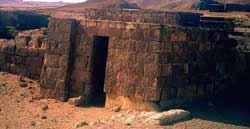
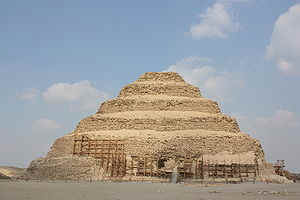
A mastaba (left), http://www.ancient-egypt-online.com/images/mastabas.jpg; the step pyramid of Djoser (right), http://upload.wikimedia.org/wikipedia/commons/thumb/3/3e/Pyramid_of_Djoser_2010.jpg/300px-Pyramid_of_Djoser_2010.jpg
Imhotep
was not only a brilliant architect but also became known as a great healer and
a master of the art of writing. An inscription on the pyramid calls him
"Chancellor of the king of Lower Egypt, . . . hereditary prince,
controller of the palace, great seer, . . . builder and sculptor." So great
was his reputation that long after his death he came to be worshipped as a god
in his own right. Eventually, architects like Imhotep developed the early,
cruder forms into highly sophisticated and mathematically perfect pyramids.
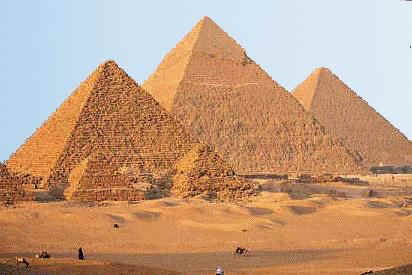
The Great Pyramid complex on the Giza plateau. http://www.pagefarm.net/wiki/index.php?title=Image:Pyramid3.jpg
Most of the eighty or so pyramids that still stand cluster
in groups along the west bank of the Nile. The best known are at Giza, including
the Great Pyramid, built about 2600 B.C. as the tomb of the pharaoh Cheops.
Egyptian architects and engineers proved themselves to be among the most skilful
in the ancient world. Orienting their pyramids on perfect north/south axes, with
a precision difficult to match even today, they apparently built upward sloping
ramps, along which workers pushed or pulled enormous stones weighing many tons,
course by course into the sky. Once the basic stones were in place, casing
stones of marble or granite were laid over them to make the sides perfectly
smooth. The final touch was probably to polish their entire surfaces until they
gleamed in the sunlight, visible for miles around – a mute but inescapably
magnificent testimony to the immortality of the pharaohs who occupied them
through the long ages of eternity.
Education. Over time Egypt developed a bureaucracy, a complex
governmental structure in which civil servants carried out many specialized
tasks. The Egyptian bureaucracy required many scribes to keep records. The
scribes were all men, and they enjoyed positions of honor. Although women were
not permitted to be scribes, some women among the upper classes were probably
literate. During the Old Kingdom, boys were usually trained by their fathers to
read and write. After the Old Kingdom fell, however, many of the skills needed
to run a state were lost. As literacy rates fell, the old system of fathers
teaching sons was no longer adequate. By the rise of the Middle Kingdom, actual
schools had begun to appear.
Farming
and trade.
While the magnificence of the pharaohs and their courtiers tend to draw most of
our attention, ordinary Egyptians, the vast majority of the population,
continued to center their lives on food production – especially farming along
the Nile. Farmland in Egypt was divided into large estates. Peasants did most of
the farming, using crude hoes or wooden plows. They kept only part of their
crops, however, paying the rest in rent or taxes for pharaoh. The most important
grain crops were wheat
and barley. Farmers also grew flax, a fibrous plant that could be spun and woven
into linen.
So
rich was the soil, because of the annual flooding and deposits of silt, that
ancient Egypt almost always produced more food than its people required. Such
surpluses not only made possible the development of civilization within the
Valley itself, but also contributed to the growth of long-distance trade as
Egyptian merchants exchanged Egypt’s products for items from beyond their
borders.
Living along the Nile, Egyptians had learned early on to use the river as a highway, building boats out of the papyrus reeds that grew in such abundance along its banks. While the current could be counted on to carry them downstream, they soon learned to use large triangular sails to take advantage of prevailing northerly winds to carry them back upstream, against the current. Having thus mastered sailing on the Nile, it was not long before Egyptians also built seagoing ships that sailed the Mediterranean, Red, and Aegean Seas, as well as along the African coast. Egyptian merchants also traveled overland, joining caravans east into Asia and south into Africa. Through the richness of her soil, her ability to trade its products for the wealth of neighboring lands, and the security provided by her natural geography, Egypt became the wealthiest and most peaceful of the ancient world’s civilizations.
